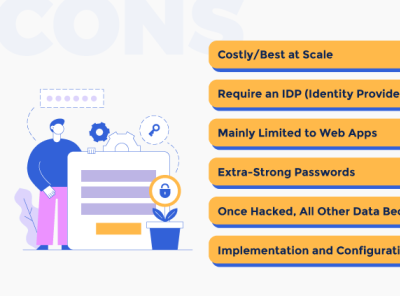Advantages Disadvantages of Single Sign on Solutions
Read up on the benefits of single sign-on systems. Make it possible for users to sign into several services with the same credentials. Single sign-on (SSO) allows users to log in once and then access multiple programmes using the same credentials. Given that a single login password grants access to many systems, we'd like to spare users the hassle of having to reauthenticate themselves whenever they switch between applications. Now let's introduce SSO to the mix. When logging into an SSO-enabled app, users just need to do so once, saving them time and effort.
The Advantages of a Single Sign-On
Web application single sign on solutions are used by businesses to facilitate speedy user access to their web applications, reducing the workload of both IT departments and end users. Take a look at the many benefits that a single Sign-on can provide to your company:
Manage Passwords Easily
One of the primary benefits of SSO is the simplicity with which credentials may be managed. In fact, with most web app SSO solutions, users don't even need passwords to log in to applications. In the end, SSO just necessitates that IT Administrators handle their users through their primary directory service (IdP). After establishing that fundamental identity, the SSO solution attests to it for arbitrary online applications.
Admin control increased
With SSO, IT administrators can know which programmes end users have access to, reducing the danger that Shadow IT and other risk factors will go unnoticed. Administrators can prohibit user access to specific apps, limiting threat vectors. User lifecycle management, where contemporary SSO platforms can automatically supply and de-provision users through SCIM and SAML JIT, has improved SSO solution advantages over time.
Fast, Secure, and Reliable Sign-In Procedures
Each month, the typical user spends 48 minutes entering and resetting passwords. This may not seem significant, but it is in contexts where prompt action is required, such as the medical and law enforcement fields. However, when SSO is enabled, users have instantaneous access to the apps they need to handle any circumstance.
Enhancements Security
SSO simplifies the handling of multiple passwords, lowering hostile users' attack points. This decreases risk for your business and its affiliates (partners and clients), especially when MFA is added to SSO. Administrators may simply change access permissions, protecting your firm from former employees. Advanced SSO techniques like push MFA and restricted access can enable better authentication methods and add an extra layer of Single Sign-On security.
Less password fatigue
Password fatigue may complacent even the most cautious employee. Password fatigue occurs when consumers create too many new credentials over time, causing them to take shortcuts like writing down and repeating old passwords. By eliminating password-based sign-in procedures with SSO, password fatigue is reduced.
Less help desk calls
SSO streamlines password management software, which relieves IT help desks' workload and saves time and money. A password request costs the help desk $70 in labour.
The Disadvantages of Single Sign-On
Web application SSO has many benefits, but it also has several drawbacks and potential dangers. The following are some of SSO's drawbacks:
Expensive and optimal for large-scale use
SSO can be costly. Small businesses might benefit from SSO, but it can be costly. Many SSO businesses charge add-on fees for vital functionality, driving up prices.
IDP needed (Identity Provider)
An organization's IdP/directory service is the foundation of SSO. Single Sign-On is built on a directory, forcing organisations to pay extra services to achieve their aims, making the package resource-intensive and complicated. Like SSO, this can be expensive for enterprises in setup and recurring fees.
Web-apps-only
IAM involves several IT team responsibilities. IAM goes beyond SSO for web app access. IT administrators must use other tools outside web app SSO to create a comprehensive IAM solution. Users need access to Mac, Windows, Linux, servers, VPNs, WiFi networks, file servers, and more. For these IT resources, SSO is pointless.
Strong passwords
SSO requires only one password, but it's best if it's long, tough, and secure. This raises the possibility that a user will forget or divulge their password, rendering Single Sign-On worthless.
Once hacked, all data is vulnerable
Since SSO is tied to many vital resources, if a provider is attacked, all users are at danger. If MFA isn't implemented, an end user's SSO portal compromises application access.
Summing It Up
We utilise many platforms daily, and remembering complicated passwords is difficult. SSO could solve this issue. We can access different apps and services with a single identity, and adding and deleting users will be easy. Your firm doesn't need SSO system or expertise. Ninja Auth is one of the better solutions and can help your organisation.
